Impact of Tree Species on Magnitude of PALSAR Interferometric Coherence over Siberian Forest at Frozen and Unfrozen Conditions
Abstract
:1. Introduction
2. Study Area and Data
2.1. Study Area
2.2. Forest Inventory Data
2.3. Meteorological Data
2.4. PALSAR Data
3. Methodology
3.1. Coherence Data Processing and Approach of Investigation
3.2. Statistical Analysis of |γ|
- (i)
- Average and standard error of |γ| of all stands with dense forest (250–350 m3·ha−1);
- (ii)
- Average and standard deviation of |γ| separated by species;
- (iii)
- Deviation of tree species specific |γ| from average |γ| over dense forest;
- (iv)
- T-tests to evaluate significance of difference.
4. Results and Discussion
5. Conclusions
Acknowledgments
Author Contributions
Conflicts of Interest
References
- Koskinen, J.T.; Pulliainen, J.T.; Hyyppä, J.M.; Engdahl, M.E.; Hallikainen, M.T. The seasonal behavior of interferometric coherence in boreal forest. IEEE Trans. Geosci. Remote Sens 2001, 39, 820–829. [Google Scholar]
- Eriksson, L.E.B.; Santoro, M.; Wiesmann, A.; Schmullius, C.C. Multitemporal JERS repeat-pass coherence for growing-stock volume estimation of Siberian forest. IEEE Trans. Geosci. Remote Sens 2003, 41, 1561–1570. [Google Scholar]
- Pulliainen, J.; Engdahl, M.; Hallikainen, M. Feasibility of multi-temporal interferometric SAR data for stand-level estimation of boreal forest stem volume. Remote Sens. Environ 2003, 85, 397–409. [Google Scholar]
- Thiel, C.; Schmullius, C. Investigating ALOS PALSAR interferometric coherence in central Siberia at unfrozen and frozen conditions: implications for forest growing stock volume estimation. Can. J. Remote Sens 2013, 39, 232–250. [Google Scholar]
- Thiel, C.; Schmullius, C. Investigating the impact of freezing on the ALOS PALSAR InSAR phase over Siberian forests. Remote Sens. Lett 2013, 4, 900–909. [Google Scholar]
- Santoro, M.; Fransson, J.E.S.; Eriksson, L.E.B.; Magnusson, M.; Ulander, L.M.H.; Olsson, H. Signatures of ALOS PALSAR L-band backscatter in Swedish forest. IEEE Trans. Geosci. Remote Sens 2009, 47, 4001–4019. [Google Scholar]
- Dobson, M.G.; McDonald, K.; Ulaby, F.T. Effects of Temperature on Radar Backscatter from Boreal Forests. Proceedings of the 1990 IEEE International Geoscience and Remote Sensing Symposium (IGARSS), College Park, MD, USA, 20–24 May 1990; pp. 2481–2484.
- Kwok, R.; Rignot, E.J.M.; Way, J.; Freeman, A.; Holt, J. Polarization signatures of frozen and thawed forests of varying environmental state. IEEE Trans. Geosci. Remote Sens 1994, 32, 371–381. [Google Scholar]
- Eriksson, L.E.B.; Schmullius, C.C.; Wiesmann, A. Temporal Decorrelation of Spaceborne L-Band Repeat-Pass Coherence. Proceedings of the Parameters from SAR Data for Land Applications BioGeoSAR, Innsbruck, Austria, 16–19 November 2004. (CD-ROM).
- Santoro, M.; Askne, J.; Smith, G.; Fransson, J.E.S. Stem volume retrieval in boreal forests from ERS-1/2 interferometry. Remote Sens. Environ 2002, 81, 19–35. [Google Scholar]
- Hyyppä, J.; Hallikainen, M. Applicability of airborne profiling radar to forest inventory. Remote Sens. Environ 1996, 57, 39–57. [Google Scholar]
- Solberg, S.; Astrup, R.; Gobakken, T.; Næsset, E.; Weydahl, D.J. Estimating spruce and pine biomass with interferometric X-band SAR. Remote Sens. Environ 2010, 114, 2353–2360. [Google Scholar]
- Izzawati; Wallington, E.D.; Woodhouse, I.H. Forest height retrieval from commercial X-band SAR products. IEEE Trans. Geosci. Remote Sens 2006, 44, 863–870. [Google Scholar]
- Santoro, M.; Shvidenko, A.; McCallum, I.; Askne, J.; Schmullius, C. Properties of ERS-1/2 coherence in the Siberian boreal forest and implications for stem volume retrieval. Remote Sens. Environ 2007, 106, 154–172. [Google Scholar]
- Castel, T.; Martinez, J.M.; Beaudoin, A.; Wegmuller, U.; Strozzi, T. ERS INSAR data for remote sensing hilly forested areas. Remote Sens. Environ 2000, 73, 73–86. [Google Scholar]
- Askne, J.; Santoro, M. Multitemporal repeat pass SAR interferometry of boreal forests. IEEE Trans. Geosci. Remote Sens 2005, 43, 1219–1228. [Google Scholar]
- Proisy, C.; Mougin, E.; Lopes, A.; Sarti, F.; Dufrêne, E.; Ledantec, V. Temporal Variations of Interferometric Coherence over a Deciduous Forest. Proceedings of the SAR Workshop: CEOS Committee on Earth Observation Satellites, Toulouse, France, 26–29 October 1999; p. 25.
- Wagner, W.; Luckman, A.; Vietmeier, J.; Tansey, K.; Balzter, H.; Schmullius, C.; Davidson, M.; Gaveau, D.; Gluck, M.; Toan, T.L.; et al. Large-scale mapping of boreal forest in SIBERIA using ERS tandem coherence and JERS backscatter data. Remote Sens. Environ 2003, 85, 125–144. [Google Scholar]
- National Forest Inventory (NFI). National Forest Inventory Guidelines (In Russian); Russian Federation: Moscow, Russia, 2009; Volume 1. [Google Scholar]
- Rosenqvist, A.; Shimada, M.; Ito, N.; Watanabe, M. ALOS PALSAR: A pathfinder mission for global-scale monitoring of the environment. IEEE Trans. Geosci. Remote Sens 2007, 45, 3307–3316. [Google Scholar]
- Wegmüller, U. Automated and Precise Image Registration Procedures. Proceedings of the 1st International Workshop on Multitemp, Trento, Italy, 13–14 September 2001; pp. 37–49.
- Wegmüller, U. SAR Interferometric and Differential Interferometric Processing. Proceedings of the IEEE International Geoscience and Remote Sensing Symposium (IGARSS), Seattle, WA, USA, 6–10 July 1998; pp. 1106–1108.
- Santoro, M.; Werner, C.; Wegmüller, U.; Cartus, O. Improvement of Interferometric SAR Coherence Estimates by Slope-Adaptive Range Common Band Filtering. Proceedings of the IEEE International Geoscience and Remote Sensing Symposium (IGARSS), Barcelona, Spain, 23–28 July 2007; pp. 129–132.
- Touzi, R.; Lopes, A.; Bruniquel, J.; Vachon, P.W. Coherence estimation for SAR imagery. IEEE Trans. Geosci. Remote Sens 1999, 37, 135–149. [Google Scholar]
- López-Martínez, C.; Pottier, E. Coherence estimation in synthetic aperture radar data based on speckle noise modeling. Appl. Opt 2007, 46, 544–558. [Google Scholar]
- Rott, H.; Nagler, T.; Scheiber, R. Snow Mass Retrieval by Means of Sar Interferometry; European Space Agency-European Space Research Institute (ESA-ESRIN): Rome, Italy, 2003.
- Way, J.; Rignot, E.J.M.; Mcdonald, K.C.; Oren, R.; Kwok, R.; Bonan, G.; Dobson, M.C.; Viereck, L.A.; Roth, J.E. Evaluating the type and state of Alaska taiga forests with imaging radar for use in ecosystem models. IEEE Trans. Geosci. Remote Sens 1994, 32, 353–370. [Google Scholar]
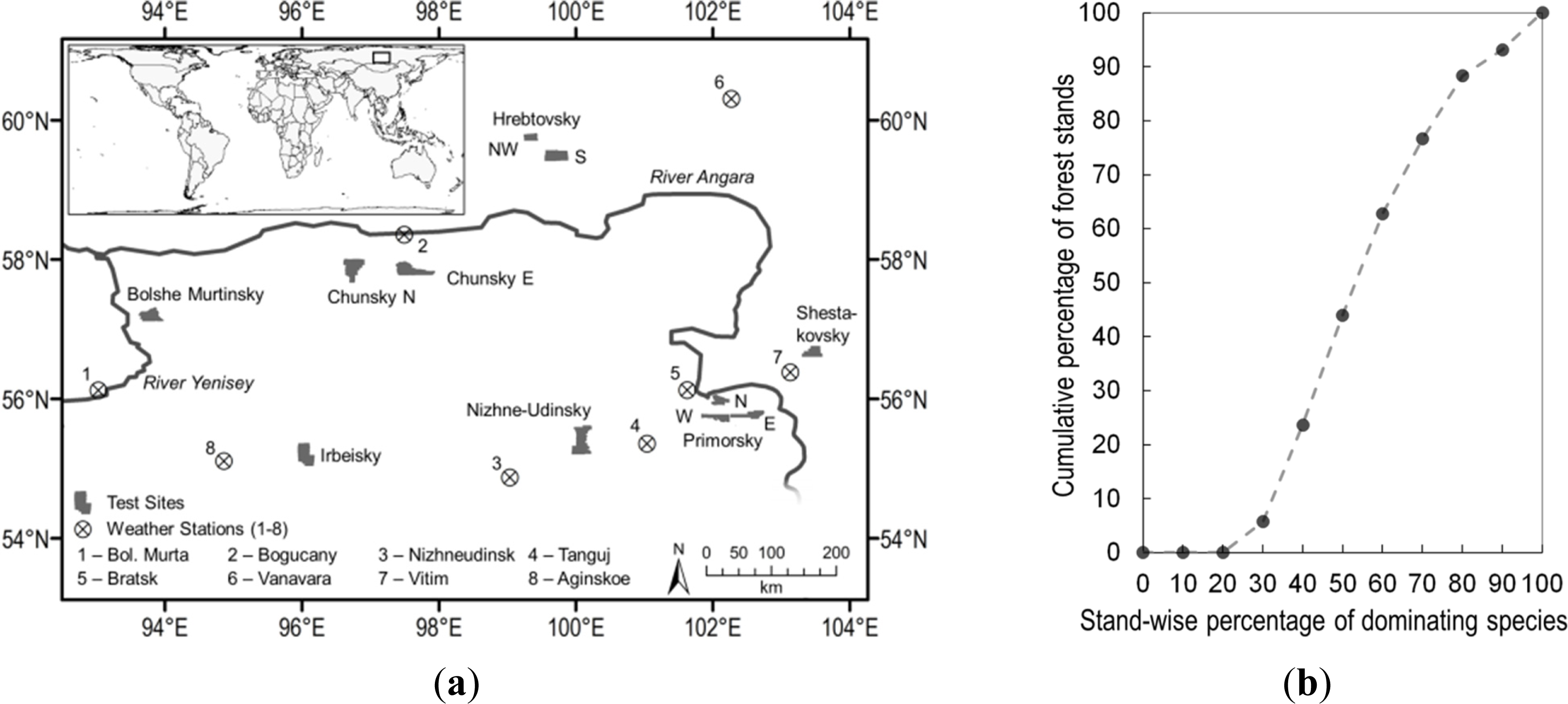
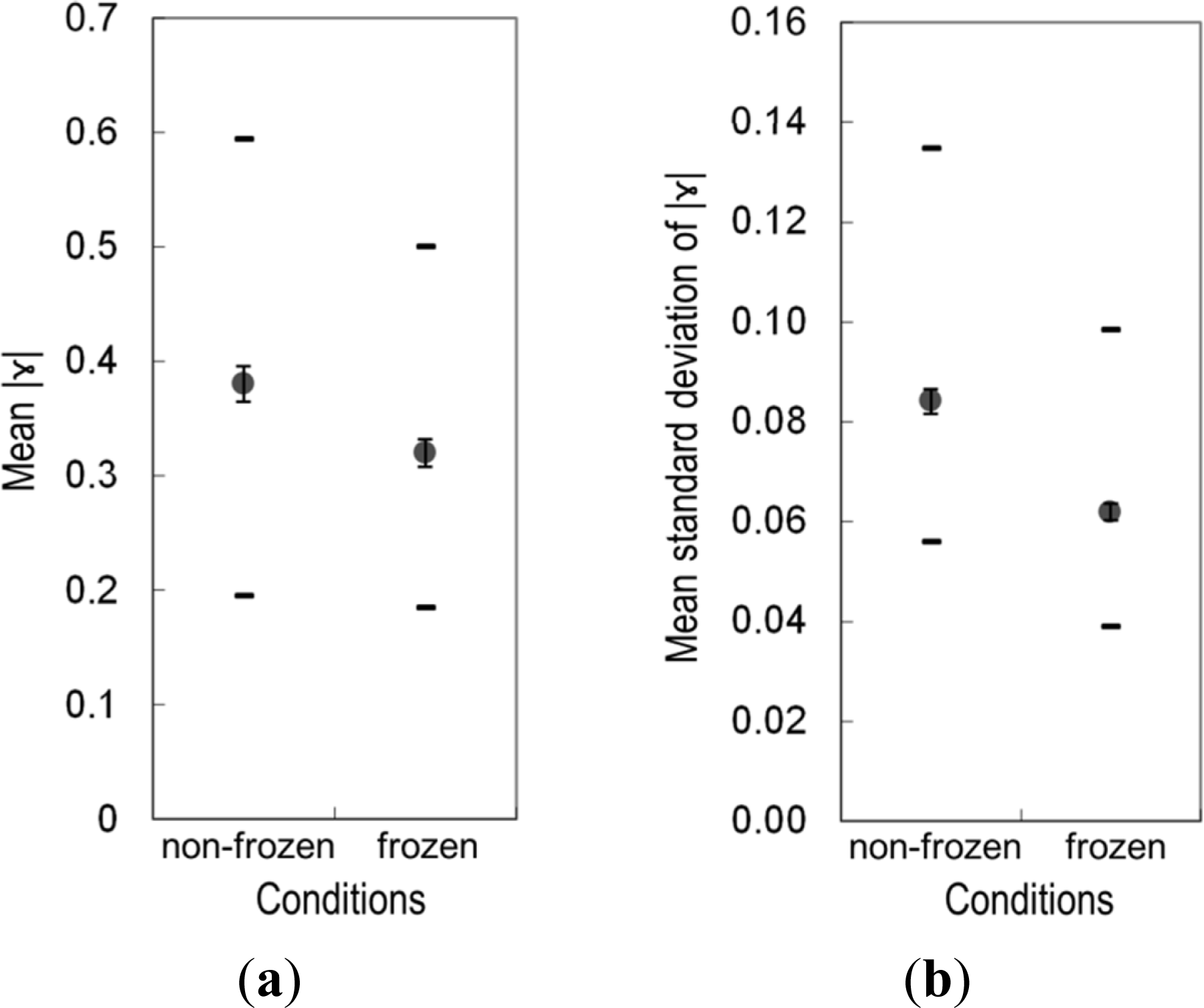
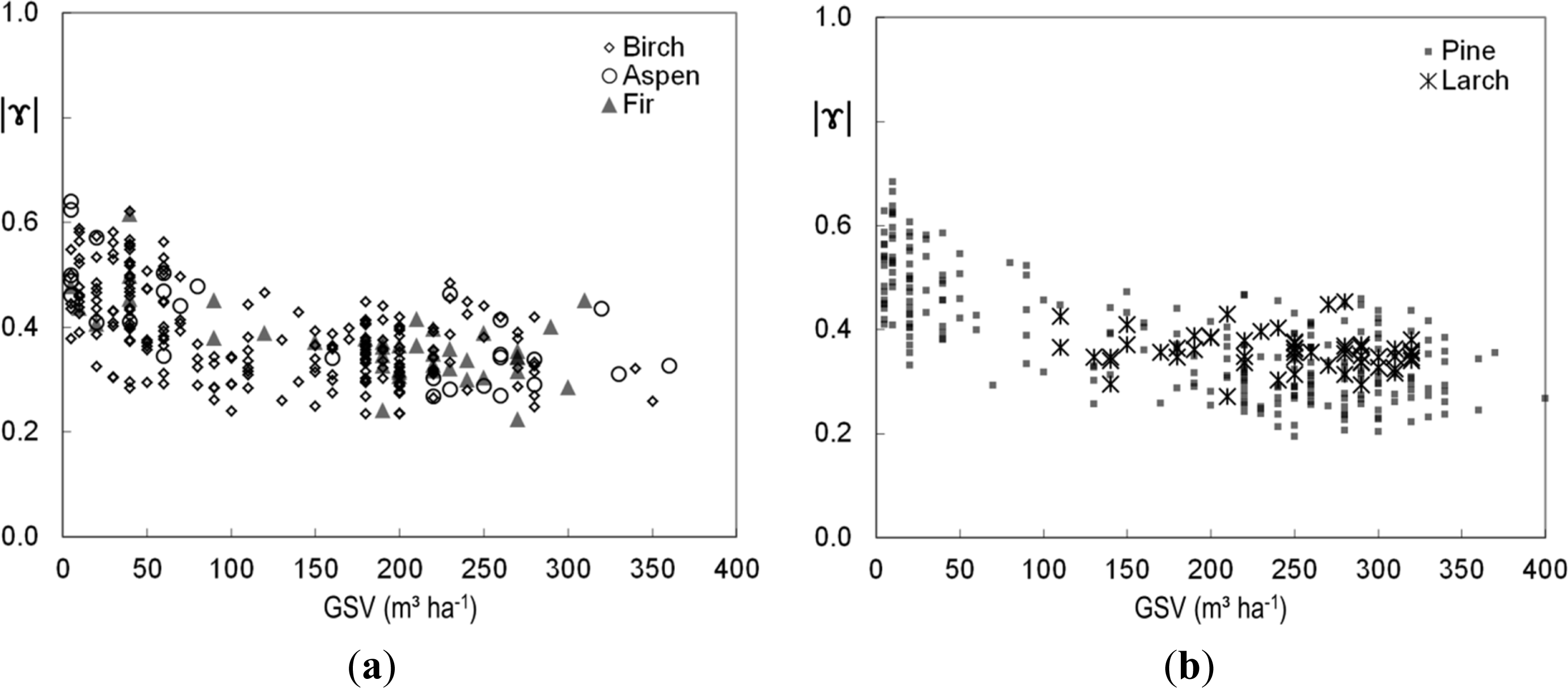
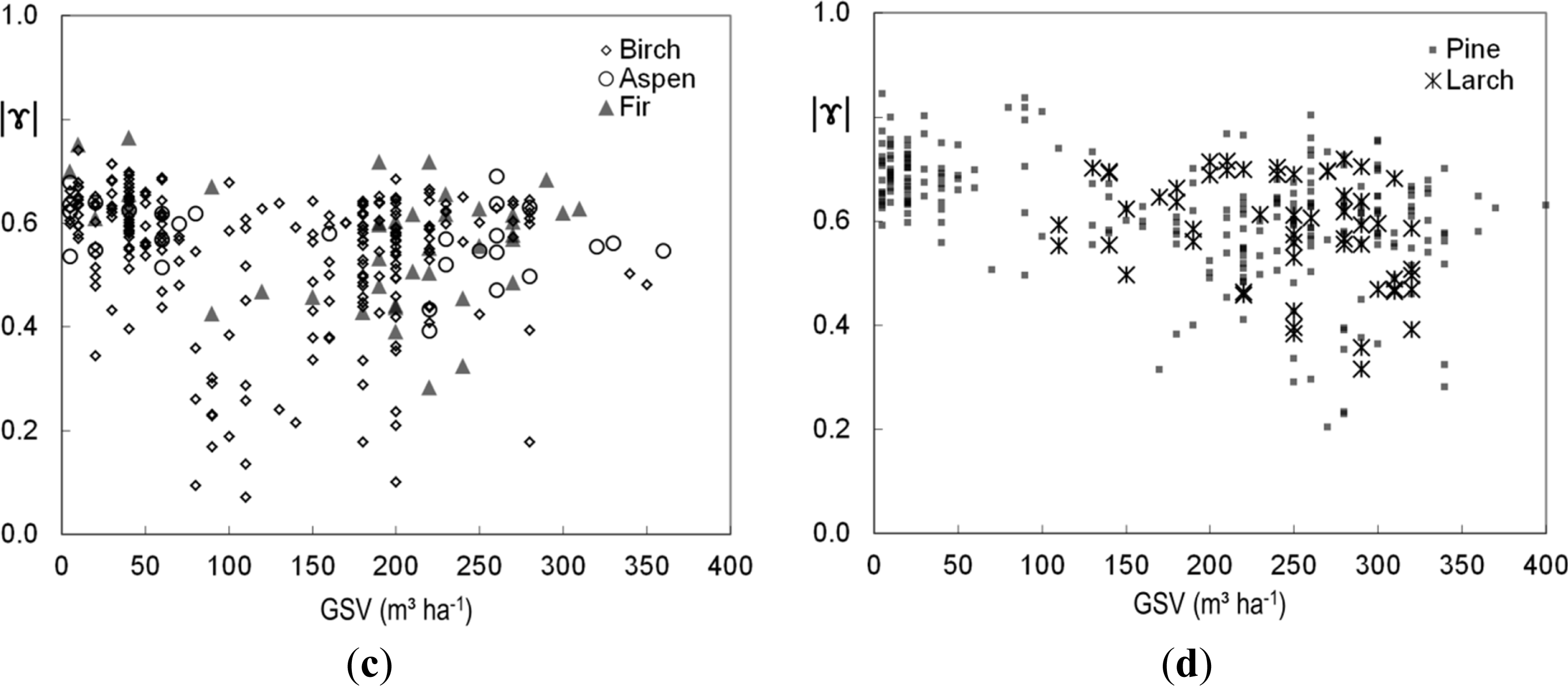
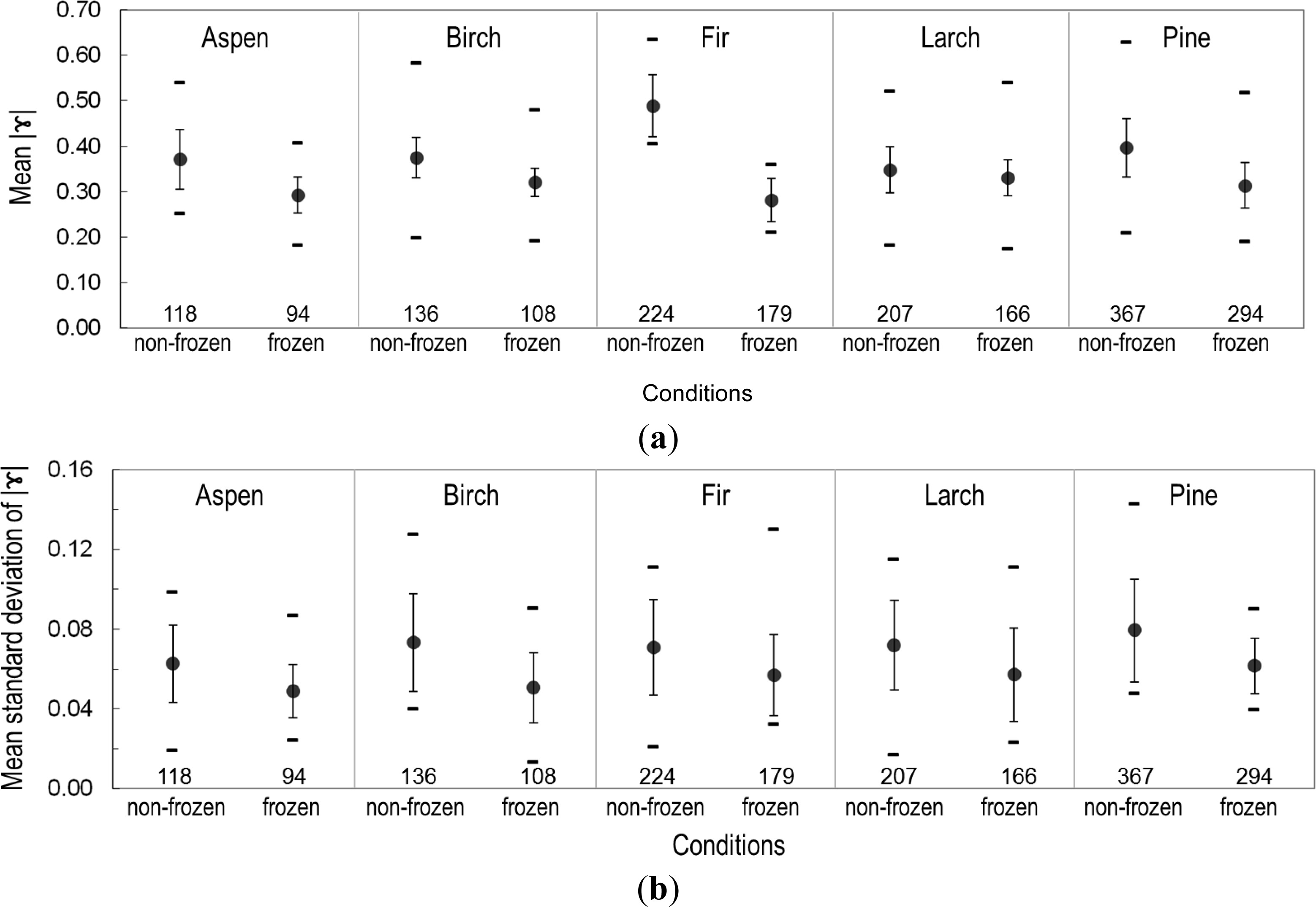
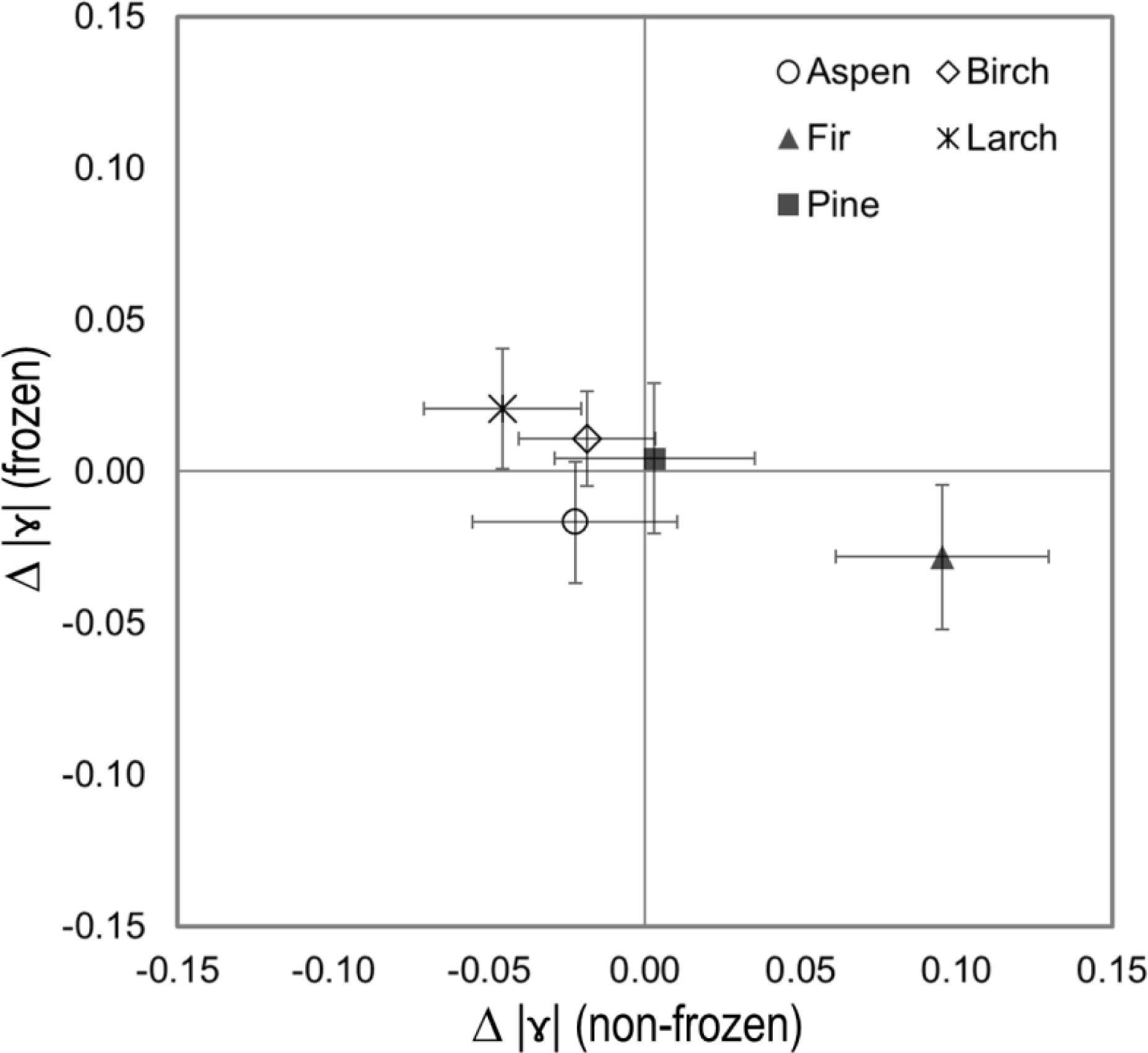
| Local Site | Size (km2) | No. of Stands | GSV (m3·ha−1) (av/med/std/min/max) | Dominant Species (Fraction ≥ 10%) |
|---|---|---|---|---|
| Bolshe NE | 278 | 1,604 | 167/190/108/0/450 | Fir (31%), Aspen (23%), Birch (15%), Spruce (10%) |
| Chunsky E | 381 | 1,113 | 115/90/115/0/430 | Birch (29%), Pine (24%), Larch (17%) |
| Chunsky N | 393 | 1,284 | 129/150/112/0/470 | Pine (21%), Birch (19%), Larch (16%), Spruce (11%) |
| Hrebtovsky NW | 105 | 339 | 191/200/70/0/320 | Pine (45%), Larch (37%) |
| Hrebtovsky S | 287 | 867 | 171/190/90/0/420 | Larch (40%), Pine (26%), Birch (13%) |
| Nishne Udinsky | 514 | 2,046 | 169/190/124/0/470 | Birch (41%), Pine (31%), Aspen (12%) |
| Irbeisky | 400 | 1,720 | 165/190/111/0/500 | Fir (28%), Birch (19%), Cedar (13%), Aspen (12%) |
| Primorsky E | 209 | 994 | 152/180/113/0/500 | Pine (34%), Birch (27%) |
| Primorsky N | 149 | 752 | 119/90/98/0/350 | Pine (44%), Aspen (22%), Birch (22%) |
| Primorsky W | 180 | 710 | 137/120/100/0/440 | Birch (36%), Pine (34%) |
| Shestakovsky | 201 | 814 | 183/210/97/0/380 | Pine (26%), Birch (24%), Larch (17%), Aspen (12%) |
| Chunsky N | Chunsky E | Primorsky | Bolshe NE | Shesta-Kovsky | Nishne Udinsky | Irbeisky | Hrebtov-Sky | |
|---|---|---|---|---|---|---|---|---|
| Track | T475 | T473 | T466 | T481 | T0463 | T0471 | T0478 | T0468 |
| Frame | F1150 | F1150 | F1110 | F1140 | F1130 | F1100 | F1100 | F1190 |
| 2006 | 30 Dec | 28 Dec | ||||||
| 2007 | 20 Jun | 14 Feb | 18 Jan | 12 Feb | 13 Jan | 11 Jan | 6 Jan | |
| 5 Aug | 2 July | 5 Mar | 15 Aug | 28 Feb | 26 Feb | 21 Feb | ||
| 20 Sep | 17 Aug | 21 Jul | 30 Sep | 16 Jul | 14 Jul | 9 Jul | ||
| 5 Nov | 2 Oct | 5 Sep | 31 Aug | 14 Oct | 24 Aug | |||
| 21 Dec | 21 Oct | 31 Dec | 26 Dec | 9 Oct | ||||
| 2008 | 5 Feb | 2 Jan | 15 Feb | 16 Jan | 10 Feb | 9 Jan | ||
| 22 Mar | 17 Feb | 2 Mar | 28 Dec | 24 Feb | ||||
| 2009 | 4 Jan | 2 Jan | 18 Jan | 16 Jan | 12 Feb | 11 Jan | ||
| 19 Feb | 17 Feb | 5 Mar | 3 Mar | 30 Jun | 26 Feb | |||
| 21 Jul | 15 Aug | 14 Jul | ||||||
| 5 Sep | 30 Sep | 29 Aug | ||||||
| 14 Oct | ||||||||
| No. inter-ferograms | 5 | 5 | 3 | 4 | 5 | 3 | 4 | 7 |
© 2014 by the authors; licensee MDPI, Basel, Switzerland This article is an open access article distributed under the terms and conditions of the Creative Commons Attribution license (http://creativecommons.org/licenses/by/3.0/).
Share and Cite
Thiel, C.; Schmullius, C. Impact of Tree Species on Magnitude of PALSAR Interferometric Coherence over Siberian Forest at Frozen and Unfrozen Conditions. Remote Sens. 2014, 6, 1124-1136. https://doi.org/10.3390/rs6021124
Thiel C, Schmullius C. Impact of Tree Species on Magnitude of PALSAR Interferometric Coherence over Siberian Forest at Frozen and Unfrozen Conditions. Remote Sensing. 2014; 6(2):1124-1136. https://doi.org/10.3390/rs6021124
Chicago/Turabian StyleThiel, Christian, and Christiane Schmullius. 2014. "Impact of Tree Species on Magnitude of PALSAR Interferometric Coherence over Siberian Forest at Frozen and Unfrozen Conditions" Remote Sensing 6, no. 2: 1124-1136. https://doi.org/10.3390/rs6021124
APA StyleThiel, C., & Schmullius, C. (2014). Impact of Tree Species on Magnitude of PALSAR Interferometric Coherence over Siberian Forest at Frozen and Unfrozen Conditions. Remote Sensing, 6(2), 1124-1136. https://doi.org/10.3390/rs6021124




